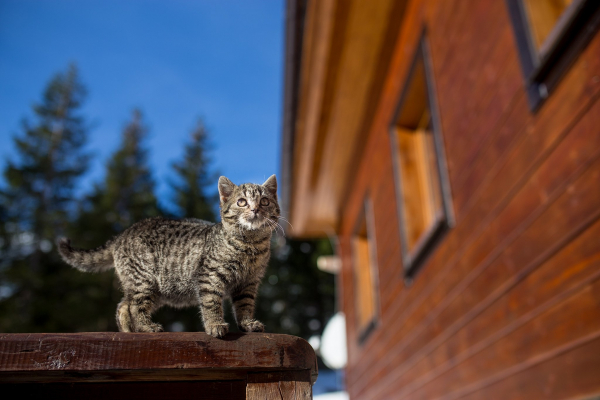Cuy morče - obr mezi morčaty
Pejska ani kočku nechcete, přesto ale toužíte po nějakém chlupatém mazlíčkovi, který se vám neztratí v náručí? Tento malý obr je pak možná právě to, co hledáte.
Have you ever watched your cat and asked yourself what it might be thinking? It sometimes seems that these furry friends enjoy situations in which you don’t know if they love your or want to claw your eyes out. They only sit and watch you from a distance. But sometimes, they can’t keep their poker face and let these emotions go out or they show them on purpose.


Have you ever watched your cat and asked yourself what it might be thinking? It sometimes seems that these furry friends enjoy situations in which you don’t know if they love your or want to claw your eyes out. They only sit and watch you from a distance. But sometimes, they can’t keep their poker face and let these emotions go out or they show them on purpose.
And sometimes, cats are betrayed by their own tails which say more than they would like to. Do you know what the reason they wag them is? It’s not that easy as some may think. It's not true that a dog wags its tail when it’s happy and cat lashes it when it’s angry. For both cats and dogs, it’s also about the way they wag it and the reasons might be opposite. If we know what we should observe, a cat’s tail can also be used to understand its feelings, even though it’s not as revealing as dogs’ tails.
But you can recognize many cats’ moods by observing it. Even from its position. Is it down or vertically erect? Does a cat lash it or slowly swing? If you know your cat, you might already have some idea of what it does with its tail in certain moods.
Still laid or freely hanging tail means absolute relaxedness. Erect tail indicates joy. A shape of a question mark signals playful mood. A bristled tail is a threat or a manifestation of aggression.
And now about the already-mentioned wagging. Free, smooth movements from one side to another may indicate happiness. But if it lashes from one side to another, it is vigilant and advises you to do the same. For example in a situation it hears an unknown or suspicious sound.
If a cat jerkily lashes its tail from one side to the other, it means excitement (both positive and negative). If it really swishes back and forth, it is really annoyed. You should stay out of its way. When a tail suddenly goes up from swishing, it’s too late. This indicates an immediate attack. If only a tip of the tail jerks, it is a threatening posture. Only one swish with a tail which is often accompanied by turning a head away means that you’re basically dead for the cat and it doesn’t care about you at all at the moment. It’s a contemptuous signal of cats.
As you case see, a cat’s tail is a really good indicator of a cat’s mood. Have you learned to understand your cat’s movements? Do you know about another mood your cat’s tail reveals?


Pejska ani kočku nechcete, přesto ale toužíte po nějakém chlupatém mazlíčkovi, který se vám neztratí v náručí? Tento malý obr je pak možná právě to, co hledáte.


Pokud váš pes žije celoročně venku, je třeba mu k tomu zřídit vhodné podmínky. Jeho bouda musí být dobře zateplená a musí být i dobře konstruovaná. Zde je pár tipů, jak na to.


Minule jsem se s vámi podělila o mé názory na kastrace obecně a vyjmenovala výhody a nevýhody tohoto zákroku u fen. Teď se pojďme podívat, jak je to u psů.


Kastrace je stále celkem ošemetné a velmi konzultované téma. Já vám dnes představím fakta o tomto zákroku a o jeho důsledcích a podělím se také o svůj názor.


Máte doma bázlivého psa, nebo hyperpsa? Pro oba se tento relativně nový sport perfektně hodí. Těm bázlivým zvedne sebevědomí a ty s nadmírou energie naučí uklidnit se a soustředit.


Příčin psího strachu může být více. A prvním krokem k jeho odbourání je zjištění jeho původu a příčiny.


Pokud doma máte jedno z chlupatých vrnících klubíček, možná víte, v jakého ďábla se některé z nich dokážou proměnit, pokud jim potřebujete podat prášek. Jestli vaše kočka patří právě mezi ty, u kterých je to téměř nadlidský úkol, mám pro vás několik...


Stejně jako u lidí, i naši mazlíci by měli chodit na pravidelné kontroly k lékaři. My to sice dost často zanedbáváme, u zvířat je to ale přeci jen něco jiného. Pes nebo kočka za vámi nepřijdou, že se necítí úplně dobře. Proto je roční kontrola u...


V životě každého psa může nastat situace, kdy je nasazení náhubku potřeba. A pokud na košík pes není zvyklý, může to znamenat stresovou situaci. Poradím vám, jak se stresu vyhnout a psa na náhubek zvyknout.


Pokud vám kočka chodí čůrat nebo kálet mimo toaletu, jen málokdy je to otázkou výchovy či hygieny. Kočky jsou chytrá a čistotná zvířata a nemají problém pochopit, kam mají chodit na záchod. Pokud tedy tyto pravidla hygieny nedodržují, je třeba problém...


O válce v Sýrii slýcháme skoro každý den. Napadlo vás ale někdy, jak se válka dotýká tamních zvířat, a že obětavost nemusí prokazovat vždy jen zvíře lidem, ale občas to může být i naopak? Člověk, o kterém vám dnes povím, zůstal ve válečné zóně, aby se...


Akupunktura má za cíl harmonizovat tělo i mysl. Možná někdo z vás akupunkturu vyzkoušel, mě osobně velmi pomohla s problémy se zády a dýcháním. Právě díky kladné osobní zkušenosti mě zaujala možnost dopřát akupunkturu také psům a kočkám.